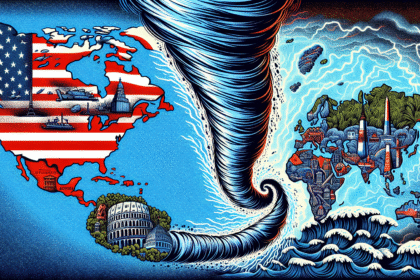Assessing the U.S. Response to Geopolitical Rivalries: China and Russia
Historical Context of U.S. Engagement
The geopolitical landscape has undergone significant shifts since the Cold War, with China and Russia emerging as formidable rivals to U.S. global influence. In navigating these challenges, the U.S. has adopted multifaceted strategies, encompassing diplomacy, military preparedness, economic sanctions, and alliances. Understanding these responses requires a historical lens on U.S. relations with China and Russia, emphasizing key events that shape current policies.
The Rise of China as a Global Power
China’s economic expanse and military modernization have propelled it into a position of global significance. Following China’s accession to the World Trade Organization (WTO) in 2001, the U.S. sought to integrate China into the global economic framework. However, as China’s assertive actions in the South China Sea and its Belt and Road Initiative illustrate, Beijing has pursued a nationalistic agenda that often conflicts with U.S. interests. The U.S. response has evolved from engagement to a more competitive and confrontational posture, particularly under the Trump and Biden administrations.
Russia’s Resurgence as a Strategic Adversary
Post-Cold War, Russia initially gravitated toward a cooperative relationship with the West. However, events such as the 2008 invasion of Georgia and the 2014 annexation of Crimea signaled a stark departure from this trajectory. The U.S. responded with economic sanctions and military support for Eastern European allies. The Kremlin’s use of hybrid warfare tactics, disinformation campaigns, and cyber operations has necessitated a comprehensive reassessment of U.S. strategy toward Russia, shifting focus toward deterrence and defense.
Military Preparedness and Alliances
American military strategy has become increasingly focused on countering Chinese and Russian aggression. In the Indo-Pacific region, the U.S. has strengthened alliances with nations such as Japan, South Korea, and Australia, while also enhancing military presence through initiatives like the Quad Security Dialogue. In Europe, NATO remains a cornerstone of U.S. defense policy, with enhancements such as increased troop deployments to Eastern Europe to reinforce deterrent capabilities against potential Russian aggression.
Economic Sanctions and Trade Policies
Economic sanctions have emerged as a prominent tool in the U.S. arsenal against both China and Russia. For Russia, sanctions imposed after the annexation of Crimea have targeted key sectors, including energy, finance, and defense. The U.S. has aimed to cripple Russia’s capacity to finance its military operations and influence in neighboring countries. Similarly, economic measures against China focus on trade imbalances, intellectual property theft, and unfair trade practices. The U.S.-China trade war initiated tariffs on hundreds of billions of dollars in goods, reflecting a strategy to reshape the economic relationship.
Technology and Cybersecurity Concerns
The technological race is a critical component of U.S. geopolitical strategy. In recent years, the U.S. has recognized the importance of securing its technological infrastructure from espionage and cyber threats posed by both China and Russia. Initiatives aimed at safeguarding 5G technology from espionage activities are of paramount importance, especially as countries ramp up their digital infrastructure. The U.S. has also implemented export controls on advanced technologies, particularly related to semiconductors, in efforts to stifle military advancements overseas.
Human Rights and Democratic Values
Another dimension of U.S. foreign policy is advocating for human rights and democratic values. This approach finds particular relevance in relation to both China and Russia. The U.S. has condemned human rights abuses in China, including the oppression of Uyghurs in Xinjiang and the crackdown on Hong Kong’s pro-democracy movement. In Russia, the suppression of political dissidents, such as Alexei Navalny, has drawn the ire of the U.S., prompting statements of condemnation and action-oriented responses.
Multilateral Engagements and Coalitions
The U.S. has increasingly sought to fortify its global leadership through multilateral engagements. In confronting China’s rise, initiatives such as the Quad and the AUKUS security pact with Australia and the United Kingdom showcase a commitment to regional security and democratic values. On the other hand, NATO represents a critical framework for collective defense against Russia’s aggressive maneuvers. The U.S. has also attempted to rally existing alliances to address global challenges, including climate change, economic stability, and pandemic preparedness, thus demonstrating a broad approach to foreign policy.
The Role of Soft Power
While military and economic responses are vital, soft power remains an essential tool in the U.S. strategy toward China and Russia. Cultural diplomacy, educational exchanges, and international development efforts enable the U.S. to project its influence. Programs aimed at promoting democratic governance, civil society engagement, and media plurality are critical in counterbalancing the authoritarian narratives propagated by both nations.
Domestic Considerations in Foreign Policy
Domestic politics play a significant role in shaping U.S. foreign policy toward China and Russia. Bi-partisan support for a tougher stance against China has emerged due to national security concerns. This shift is reflected in increased scrutiny of corporate partnerships and supply chain vulnerabilities. Conversely, Russia policy remains fraught with political divisions, complicated by questions regarding election interference and allegations of past collusion.
Future Considerations and Challenges
As geopolitical landscapes continue to shift, the U.S. response to China and Russia will require flexibility and adaptability. Emerging threats, including cybersecurity concerns and climate change, present dual considerations for national security and global stability. The rise of non-state actors and technological advancements will shape future engagements, necessitating collaboration over competition where possible.
Conclusion: A Strategic Imperative
The assessment of the U.S. response to geopolitical rivalries unveils a complex interplay of military might, economic leverage, and diplomatic outreach. As the global order evolves, maintaining a strategic balance will be essential for safeguarding U.S. interests and ensuring stability in an increasingly multipolar world. Understanding the underlying motivations and actions of both China and Russia will enable more effective policy formulation, aligning objectives with the realities of international dynamics.
By deploying a comprehensive strategy that integrates hard and soft power, the U.S. can position itself not only as a counterweight to rival influences but also as a leader in promoting a stable and rules-based international order. As competition intensifies, maintaining the integrity of democratic values while fostering strategic partnerships will be crucial.






